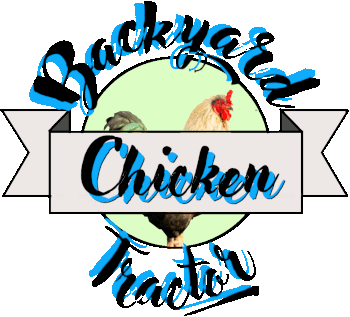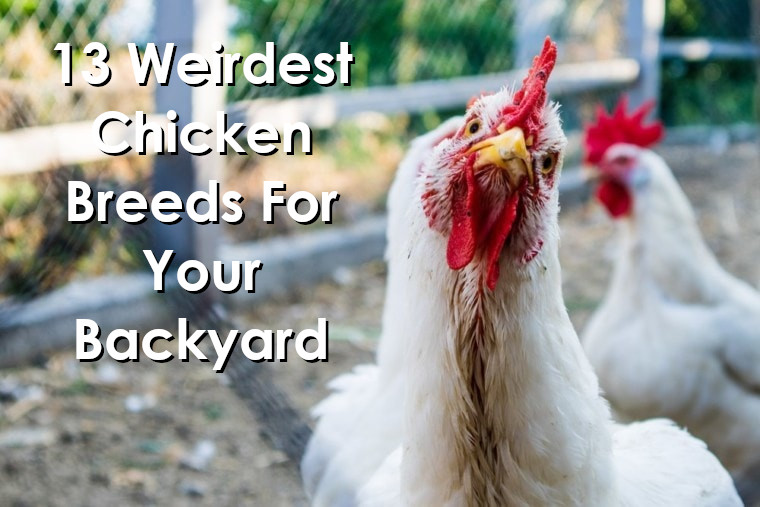
What Makes The Weirdest Chicken Breeds So Weird?
What is it that makes a weird chicken breed weird? For us, it can be a few things. They can lay weird eggs, they can have weird plumage (or no plumage at all), or they can have unusual qualities (see the Ayam Cemani). Regardless of why people consider these chickens weird, no one will argue that they’re striking. Weird chicken breeds are often rare and frequently beautiful and undoubtedly deserved to be considered for your backyard chicken flock.
Why Raise The Weirdest Chicken Breeds
There are a lot of reasons people raise weird chicken breeds. It’s true that some weird chicken breeds are good egg producers and some are good meat chickens, but let’s be honest – you came here because you want an amazing chicken in your backyard that you can show off. We’ll show you our top picks for the weirdest chicken breeds and we hope you’ll fall in love with one or two and help conserve these bizarre chicken breeds.
Frizzle
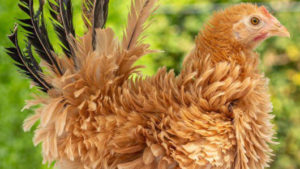
Purpose: Ornamental
Weight: 5 – 6 lbs
Egg Production: 100 – 150 eggs a year
If a ‘standard chicken’ is not what you’re after, then the Frizzle is the chicken for you. These little weirdos have a long history that dates back to the 1600s. Their characteristic fluff is caused by a dominant genetic trait. Unfortunately, breeding two Frizzles together can result in a bird that has two copies of the Frizzle gene (called a Frazzle) which can cause severe problems with their feathers. Frizzles are usually bred with other varieties for that reason.
These chickens make an amazing weird chicken breed for backyard chicken enthusiasts. These fluffy feather dusters have a beautifully docile temperament and make excellent pets. Good thing, because they’re not great for meat and don’t produce many eggs compared to other chickens.
Your Frizzles should be kept well protected. They don’t do well in extreme heat or cold and they chill easily when damp. They also lack the ability to fly and their fluff tends to obstruct their vision so they need to be kept safe from predators at all times. These chickens aren’t too active, so about 2 square feet per chicken should be sufficient in a chicken coop.
Aracuana (rumpless)
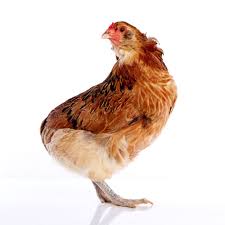
Purpose: Egg Laying
Weight: 4 – 5 lbs
Egg Production: 150 – 160 eggs a year
Aracuana chickens have two claims to fame and both earn them a spot as one of the weirdest chicken breeds. The first is that they lay beautiful blue eggs. The second is that they have absolutely no tail feathers.
Aracuana chickens were created in Chile in the early 1900s by the selective breeding of native birds. Today they’re primarily bred for their stunningly colored eggs. While pure Aracuana chickens lay blue eggs, hybrids will lay a variety of colors including greenish blue, green, yellow, or pink. While they don’t lay a ton of eggs, these backyard chickens are still sought after for their egg color alone.
This weird chicken can be difficult to breed as the ear tuff trait can have a lethal allele that will cause a high mortality rate in chicks. You could lose as much as a fifth of your clutch if one parent has the fatal allele or all of it if both parents have it.
Aracuanas are great foragers and love to roam. Make sure you have at least 4 sq. ft. per chicken. More will be greatly appreciated by your flock.
Silkie
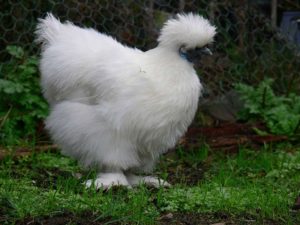
Purpose: Ornamental
Weight: 1.5 – 2.5 lbs
Egg Production: 100 – 120 eggs a year
Everything about the Silkie screams ‘weird chicken breed’. Their feathers look more like puffy fur. Their earlobes are blue and they’re black from their skin to their bones. They’re just weird!
The Silkie is an ancient breed that dates back before the thirteenth century. Their black meat and bones made them a prized bird in Chinese folk medicine, but the reason these chicken weirdos are loved these days is their soft, fluffy feathers and friendly demeanor.
Silkies don’t need a lot of space and are often favored by backyard farmers who want a pet. In fact, the Silkie doesn’t do well in either extremely hot or cold conditions so they’re better suited to temperate climates or even as a house pet.
These chickens aren’t particularly large and don’t lay many eggs, but they’re beautiful, sweet, and unique enough to earn a spot on our list of the weirdest chicken breeds for your backyard flock.
Sultan
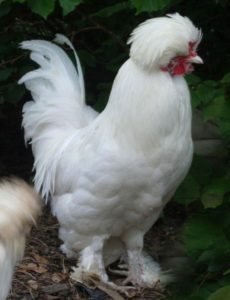
Purpose: Ornamental
Weight: 4 – 6 lbs
Egg Production: ~ 50 eggs a year
The Sultan is another weird chicken that’s found a niche as a pet chicken. Once kept by Turkish royalty, this bird is now popular around the world. Puffy feathers around their head and feet give them a regal look. Like the Silkie, Sultans are sweet birds that aren’t the greatest free-range birds and make better pets than they do meat or egg chickens. Another great thing about these weird chickens is that they don’t pick and scratch at the ground as much as most other breeds. This strange fact makes them the perfect ornamental chicken for gardens since they won’t pick the landscape bare like most other chickens will. Definitely weird.
Polverara
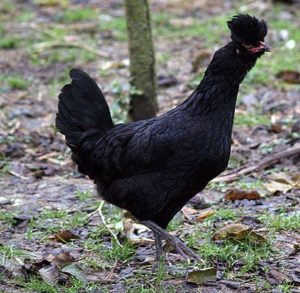
Purpose: Dual Purpose
Weight: 3 – 4.5 lbs
Egg Production: ~150 eggs a year
The Polverara is a punk rock chicken that gets its name from the town in the Veneto region of Italy where it originated. The defining characteristic of this weird chicken is its crest which can be puffy like a Java chicken or almost mohawk-like (much cooler in our opinion).
Polveraras are a rare chicken breed that’s rarely seen outside its home in Italy. It almost went extinct on two separate occasions but seems to be making a small comeback today. While not the largest of birds, the meat is reported to be pretty tasty and their egg production is modest but acceptable. Both of which make it a good dual-purpose chicken for backyard chicken farmers who want the benefit of both in addition to preserving a beautiful chicken.
The rarity of this bird makes it hard to find any information on keeping them, but they’ve been kept on farms in the Veneto region since the 1400s so it’s safe to assume that they’re good foragers that do well in temperate climates.
Laced Polish
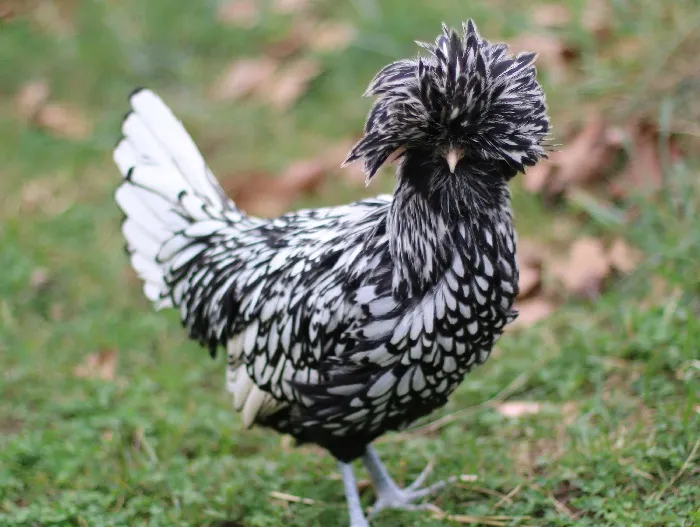
Purpose: Ornamental
Weight: 3 – 5 lbs
Egg Production: 150 -200 eggs a year
Do you like the crest of the Polverara and think ‘I wish there was a chicken that had that fluff all over its head like a feathery lollipop’? Then meet the Laced Polish chicken. The Laced Polish dates back to at least the 16th century and is still popular today due to its whimsical look.
This weird chicken is a decent egg layer and has a mild temperament making it great as a pet but prone to being bullied in a mixed flock. It does well in confinement and even requires it to keep it safe. Their gorgeous poofy head may look amazing, but it restricts their vision and makes them easy pickings for predators. About 4 sq. ft. per bird is good.
-
Aivituvin Wooden Chicken Coop, Large Outdoor Hen House with Nest Box Poultry Cage, Rabbit Hutch – Waterproof UV Panel…
Chicken Coops $119.99Rated 0 out of 5 -
Ogrmar Chicken Coop Large Wooden Outdoor Bunny Rabbit Hutch Hen Cage with Ventilation Door, Removable Tray & Ramp Garden…
Chicken Coops $179.99Rated 0 out of 5 -
Best Choice Products 80in Outdoor Wooden Chicken Coop Multi-Level Hen House, Poultry Cage w/Ramps, Run, Nesting Box…
Chicken Coops $199.99Rated 0 out of 5 -
zoovilla Country Style Chicken Coop Metal Nest Box with Asphalt Roof Panels
Chicken Coops $287.79Rated 0 out of 5 -
ECOLINEAR Outdoor 80” Wooden Chicken Coop Nest Box Hen House Poultry Pet Hutch Garden Backyard Cage (Chicken Coop)
Chicken Coops $151.99Rated 0 out of 5
Onagadori
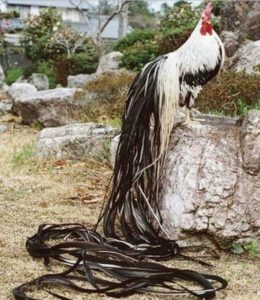
Purpose: Ornamental
Weight: 3 – 4 lbs
Egg Production: 80 – 100 eggs a year
(You want a rooster, of course, so kiss your eggs goodbye)
The name of this weird chicken breed says it all. Onagadori means ‘Long-tailed Chicken’ and that’s the trait that earned this chicken a spot on our list of the weirdest chicken breeds. The Onagadori was first bred in the 1600s and earned the distinction of becoming one of Japan’s national treasures in 1952. It’s the only chicken to have the status of ‘Special National Treasure’.
Unlike most other chickens on our list, the roosters are the Onagadori sought after. Their tails can be up to 24 feet in length and these weird chickents requires special coops with roosts high enough to keep their tails off the ground and clean.
Are you dazzled by the beauty of these unique chickens? Do you feel like you just have to have one? Well, good luck. It’s thought that there are no true Onagadori in the US and only around 1000 in Japan. (But drop us a line if you want to sell one because we REALLY want it!)
Naked Neck
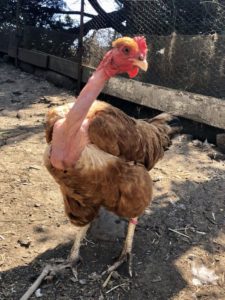
Purpose: Dual Purpose
Weight: 6 – 9 lbs
Egg Production: 150 – 200 eggs a year
Naked Neck chickens are sometimes called Turkens since they kinda look like a cross between a turkey and a chicken. As the name implies, they have no feathers on their neck. They also have fewer feathers on the rest of their body which gives them a frizzled look.
The Naked Neck gene was played with in North America and in eastern Europe, but German gave us the Naked Neck chicken we have today in the 19th century. It’s a fairly hardy weird chicken breed that can handle both warm and cooler temperatures.
The fact that this weird chicken breed has ~ 50% fewer feathers comes with a few advantages. It’s easier to pluck and also needs less protein in its diet. Not a bad trade-off.
These chickens do pretty well in confinement, but they’re on the larger side. Plan to have 4 square feet per chicken.
Naked Chickens
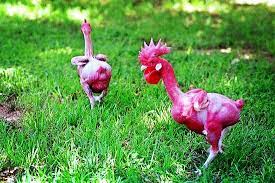
Purpose: Meat
Weight: ?
Egg Production: ?
Like the idea of a Naked Neck chicken but wish it was more naked? Well, here you go! The idea is good in theory. Breed a chicken without feathers so you don’t have to pluck it. There are downsides, however. One is that it can be a bit off-putting to watch a live roaster running around.
The Naked or Featherless chicken first made an appearance in 2002, though the breeding project took about 50 years to create it. These chickens are bred to grow quickly and do well in hotter climates despite needing shade to prevent sunburns.
Despite being around for about 20 years, we couldn’t find anyone raising these oddballs. If you have any experience with these birds, please let us know. We’d love to update their spot on the Weirdest Chicken Breed list with their weight and average egg-laying capacity.
Modern Game Bantam
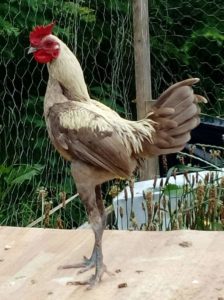
Purpose: Ornamental
Weight: 4 – 6 lbs
Egg Production: 50 – 80
The Modern Game Bantam was bred from cockfighting birds after England made the sport illegal in 1849. The result is a long-legged chicken that would look tough if it wasn’t so small. You really have to love this breed to keep them because they can be a bit of a hassle. They don’t do well in cold weather and can be aggressive.
You’ll want to make sure you have plenty of room for Modern Game Bantams if you choose to keep them. Four square feet per chicken will be fine, but give your birds time to roam free if possible.
Serama
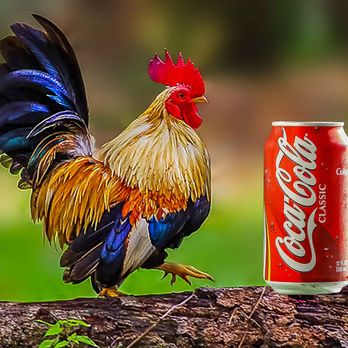
Purpose: Ornamental
Weight: 0.5 – 1.25 lbs
Egg Production: 180 – 200 eggs a year
As you look at the picture of the Serama (also called Ayam Serama), you’re probably wondering how this chicken landed on a list of the weirdest chicken breeds. It looks so…normal. But its size that matters for the Serama. It’s the world’s smallest chicken breed. They can weigh as little as half a pound and be just 6 inches tall. Adorable.
The Serama is a decent egg layer though, as you can imagine, the eggs are much smaller than normal chicken eggs. It takes five Serama eggs to equal the size of one regular chicken egg.
These birds are generally bred for ornamental purposes and kept as pets. They’re usually friendly birds and are small enough to make good house pets.
Dong Tao
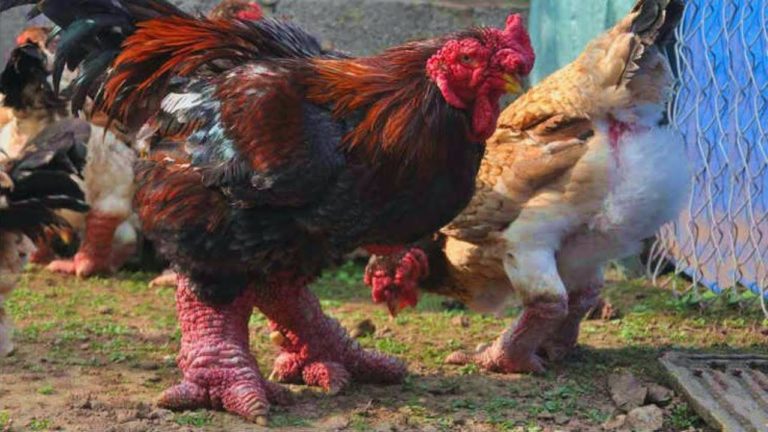
Purpose: Meat
Weight: 10 – 12 lbs
Egg Production: ~ 60 eggs per year
No list of the weirdest chicken breeds would be complete without the Dong Tao – a.k.a the Dragon Chicken. This chicken comes from Vietnam and is prized for its meat, though the thing that makes the Dong Tao so amazingly weird is its large, dinosaur-like feet. Those massive legs can be as thick as a person’s wrist.
You’ll hear rumors that these raptor-like behemoths are $2000 – $2500 for a pair. A quick internet search will show fertile eggs for as low as $140 a dozen, but it’s unclear if these are genuine or not. Even if you can get some chickens for your backyard flock, they’re not the easiest birds to care for. They don’t handle extreme temperatures well and are known to accidentally stomp their eggs.
Ayam Cemani
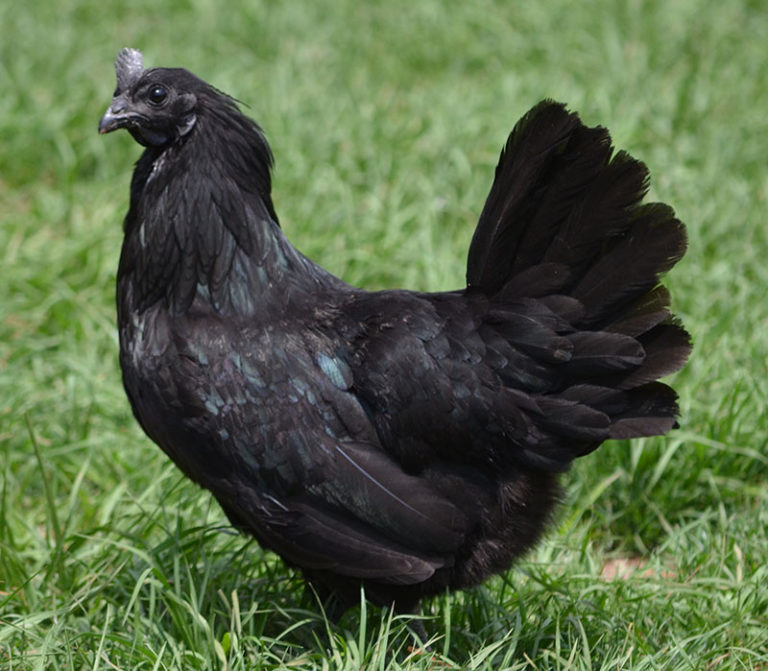
Purpose: Ornamental
Weight: 4 – 5 lbs
Egg Production: 80 eggs a year
If the color black was a chicken, it would be an Ayam Cemani. These chickens have black feathers, black skin, black comb, and black bones. They’re also a black hole for money. Like the Dong Tao, they can cost as much as $2500 a pair.
Should you be lucky enough to get your hands on a pair, you’ll find that they’re smart and gentle birds that make excellent additions to a backyard flock – that is, as long as you’re looking for beauty and not a lot of eggs. The Ayam Cemani don’t lay very many eggs and they’re not the best brooders. It’s worth noting that their eggs are the only thing about the Ayam Cemani that aren’t black. They’re kind of pinkish cream. Weird, right?
Conclusion
Let’s be honest – no one looks for weird chicken breeds to build a backyard chicken flock that lays a bunch of eggs or provides for the table. They look to these chickens because they’re fun and unique conversation starters. In a lot of cases, these oddballs get little love from conventional backyard chicken farmers and become rare breeds. Raising these birds gives backyard farmers the chance to preserve a living piece of history.
Whatever your reasons, we’re sure you’ll be happy with any of the weirdos on this list, and don’t forget to send in pictures!
-
(3 Pack) DURVET 136028 vitamins & Electrolytes, 8 oz3
Vitamins & Supplements $16.44Rated 0 out of 5 -
Animal Health Solutions – Hen Boost Probiotics, Help Boost Immunity & Hydration in Full Grown Chickens (8 oz)
Vitamins & Supplements $21.99Rated 0 out of 5 -
BOVIDR LABORATO 617407594416 Nutri-Drench Poultry Solution 4 FL OZ, Multicolor
Vitamins & Supplements $14.36Rated 0 out of 5 -
Durvet 3 Pack of Vitamins and Electrolytes for Poultry, 5 Grams, Makes 3 Gallons
Vitamins & Supplements $5.65Rated 0 out of 5 -
FRESH EGGS DAILY Organic Coop Kelp Feed Supplement Vitamins for Backyard Chickens and Ducks 1LB
Vitamins & Supplements $29.95Rated 0 out of 5 -
FRESH EGGS DAILY Poultry Probiotics Feed Supplement Vitamins for Backyard Chickens and Ducks 1LB
Vitamins & Supplements $29.95Rated 0 out of 5
